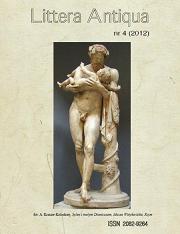Hieros logos – hieros gamos. Problem pars media w Hymnach Orfickich
Hieros logos – hieros gamos. A problem of pars media in the Orphic Hymns
Author(s): Emilia Żybert-PruchnickaSubject(s): Literary Texts
Published by: Katolicki Uniwersytet Lubelski Jana Pawła II - Instytut Filologii Klasycznej
Keywords: Orphic Hymns; pars media; prose; myth; mystery; sacred words
Summary/Abstract: Cult poems from a collection of 87 Homeric hymns have got triple structure: invocatio, pars media, consisting mostly of epithets of the gods and goddesses, and praeces ipsae. Apparently, they seem to lack the pars epica: indeed, in 79 of 87 hymns there is not any. But in the remaining eight hymns there appear traces of epic narration, which might point at the content of the orphic mysteries. Three of them refer to the myth of the rapture of Persephone (Orph. H. 18; 29; 41), three other to the story of Semele and the birth of Dionysos (Orph. H. 44; 47; 48), while the last two concern the death of Corybant (Orph. H. 39) and the birth of Melinoe, hypostasis of Hecate and Persephone in the same time (Orph. H. 71). After having compared them with other texts, especially by Pausanias, Athenagoras and Clemens Alexandrinus, it occurs that all of them refer to the act of hieros gamos between a goddess and a god, in the shape of an animal or lightning, which in effect produce a birth of a mystical offspring. The way of introducing the epic narrative into the hymn, allusive and fragmentary, may also be a sign of its mystical character, and as such be a kind of a code for those initiated in the orphic mysteries, who once had listened to a real hieros logos during the secret teletai.
Journal: Littera Antiqua
- Issue Year: 2012
- Issue No: 4
- Page Range: 147-165
- Page Count: 19
- Language: Polish

